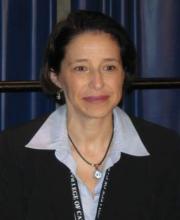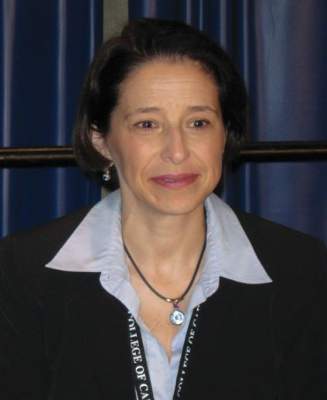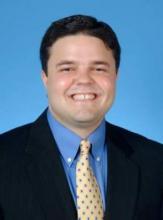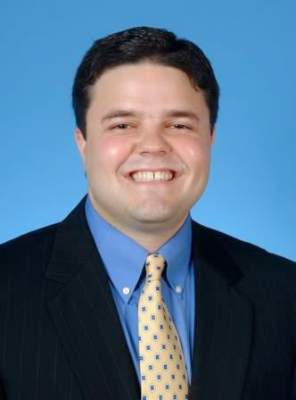User login
American Heart Association (AHA): Scientific Sessions 2015
Nitrate therapy linked to less exercise in heart failure
Isosorbide mononitrate therapy for patients with heart failure and preserved ejection fraction may actually be associated with lower levels of daily activity and does not appear to achieve significant improvements in quality of life or exercise capacity, compared with placebo.
In a double-blind crossover trial in 110 patients who were prescribed escalating doses of isosorbide mononitrate over a period of 6 weeks and then switched, those patients treated with the highest dose of 120 mg once daily showed a nonsignificant trend (P = .06) toward lower daily activity and hours of activity per day, compared with those given placebo.
According to data presented at the American Heart Association scientific sessions and published simultaneously Nov. 8 in the New England Journal of Medicine, researchers observed a decrease in average daily accelerometer units with increasing doses of isosorbide mononitrate, but not with placebo (N Engl J Med. 2015 Nov 8 [doi: 10.1056/NEJMoa1510774]).
They also noted a nonsignificant decrease in quality of life scores, N-terminal probrain natriuretic peptide, and blood pressure with isosorbide mononitrate, as well as a greater number of discontinuations and adverse events.
Although nitrates are commonly prescribed for symptom relief in heart failure, the authors said, the pathophysiology of heart failure with preserved ejection fraction may be responsible for the observed lack of improvement in exercise tolerance and daily activity.
“Increased ventricular systolic and vascular stiffness, autonomic dysfunction, chronotropic incompetence, and altered baroreflex sensitivity are common and may limit the hemodynamic benefit of nitrates,” wrote Dr. Margaret M. Redfield of the Mayo Clinic, Rochester, Minn., and her coauthors.
The National Heart, Lung, and Blood Institute supported the study. Several authors reported grants, fees, royalties and consultancies from private industry, including a patent relating to natriuretic peptide.
Isosorbide mononitrate therapy for patients with heart failure and preserved ejection fraction may actually be associated with lower levels of daily activity and does not appear to achieve significant improvements in quality of life or exercise capacity, compared with placebo.
In a double-blind crossover trial in 110 patients who were prescribed escalating doses of isosorbide mononitrate over a period of 6 weeks and then switched, those patients treated with the highest dose of 120 mg once daily showed a nonsignificant trend (P = .06) toward lower daily activity and hours of activity per day, compared with those given placebo.
According to data presented at the American Heart Association scientific sessions and published simultaneously Nov. 8 in the New England Journal of Medicine, researchers observed a decrease in average daily accelerometer units with increasing doses of isosorbide mononitrate, but not with placebo (N Engl J Med. 2015 Nov 8 [doi: 10.1056/NEJMoa1510774]).
They also noted a nonsignificant decrease in quality of life scores, N-terminal probrain natriuretic peptide, and blood pressure with isosorbide mononitrate, as well as a greater number of discontinuations and adverse events.
Although nitrates are commonly prescribed for symptom relief in heart failure, the authors said, the pathophysiology of heart failure with preserved ejection fraction may be responsible for the observed lack of improvement in exercise tolerance and daily activity.
“Increased ventricular systolic and vascular stiffness, autonomic dysfunction, chronotropic incompetence, and altered baroreflex sensitivity are common and may limit the hemodynamic benefit of nitrates,” wrote Dr. Margaret M. Redfield of the Mayo Clinic, Rochester, Minn., and her coauthors.
The National Heart, Lung, and Blood Institute supported the study. Several authors reported grants, fees, royalties and consultancies from private industry, including a patent relating to natriuretic peptide.
Isosorbide mononitrate therapy for patients with heart failure and preserved ejection fraction may actually be associated with lower levels of daily activity and does not appear to achieve significant improvements in quality of life or exercise capacity, compared with placebo.
In a double-blind crossover trial in 110 patients who were prescribed escalating doses of isosorbide mononitrate over a period of 6 weeks and then switched, those patients treated with the highest dose of 120 mg once daily showed a nonsignificant trend (P = .06) toward lower daily activity and hours of activity per day, compared with those given placebo.
According to data presented at the American Heart Association scientific sessions and published simultaneously Nov. 8 in the New England Journal of Medicine, researchers observed a decrease in average daily accelerometer units with increasing doses of isosorbide mononitrate, but not with placebo (N Engl J Med. 2015 Nov 8 [doi: 10.1056/NEJMoa1510774]).
They also noted a nonsignificant decrease in quality of life scores, N-terminal probrain natriuretic peptide, and blood pressure with isosorbide mononitrate, as well as a greater number of discontinuations and adverse events.
Although nitrates are commonly prescribed for symptom relief in heart failure, the authors said, the pathophysiology of heart failure with preserved ejection fraction may be responsible for the observed lack of improvement in exercise tolerance and daily activity.
“Increased ventricular systolic and vascular stiffness, autonomic dysfunction, chronotropic incompetence, and altered baroreflex sensitivity are common and may limit the hemodynamic benefit of nitrates,” wrote Dr. Margaret M. Redfield of the Mayo Clinic, Rochester, Minn., and her coauthors.
The National Heart, Lung, and Blood Institute supported the study. Several authors reported grants, fees, royalties and consultancies from private industry, including a patent relating to natriuretic peptide.
FROM THE AHA SCIENTIFIC SESSIONS
Key clinical point: Isosorbide mononitrate therapy may be associated with lower levels of daily activity in patients with heart failure and preserved ejection fraction.
Major finding: Patients treated with the highest dose of isosorbide mononitrate showed a nonsignificant trend toward lower daily activity and hours of activity per day, compared with patients on placebo.
Data source: A double-blind crossover trial in 110 patients with heart failure and preserved ejection fraction.
Disclosures: The National Heart, Lung, and Blood Institute supported the study. Several authors reported grants, fees, royalties, and consultancies from private industry, including a patent relating to natriuretic peptide.
Female cardiologists make about $32,000 less than male counterparts
Women in cardiology make considerably less than men do, according to research presented Nov. 8 at the American Heart Association scientific sessions.
“There was a $31,749 gender difference in salary that was not explained by the detailed measures of personal, job, and practice characteristics,” according to study coauthor Dr. Pamela S. Douglas, who presented the findings.
“The lack of gender diversity in the cardiology workforce is striking, with recent workforce estimates suggesting that women constitute only about 12% of general cardiologists and even smaller proportions of specialties like interventional cardiology and clinical cardiac electrophysiology,” according to Dr. Douglas, professor of medicine at Duke University and a member in the Duke Clinical Research Institute, both in Durham, N.C.
Using data from MedAxiom, a membership network and service provider for cardiology practices, hospitals, and academic centers, Dr. Douglas and her colleagues analyzed data on 229 women and 2,450 men from 161 practices.
They found women were less likely to have an interventional subspecialty (11% vs 39%) and were nearly twice as likely to be noninvasive cardiologists (53% vs 28%).
Women worked full time 80% of the time, compared with 91% of men (P less than .001), but worked fewer half-days (387 for women vs. 406 for men; P = .001). The number of mean number of work relative value units generated by women was 7,404, compared with 9,497 for men, (P less than . 001), according to the study, which was published simultaneously in the Journal of the American College of Cardiology.
After researchers adjusted for geographical region; practice size and makeup; measured job and productivity characteristics, such as type of subspecialty, compensation models, and the whether there was a female administrative director, Dr. Douglas said women in the analysis should have earned an average of $31,749 more than they actually did, as confirmed by a further multivariate analysis of the direction and magnitude of the independent association between gender and salary.
Women have made up about half of the enrollment at U.S. medical schools for more than a decade, but only 21% of all first-year cardiology fellows in 2012-2013 were women, according to the American Board of Internal Medicine.
“The findings should also motivate efforts to ensure equity in pay, including the promotion of greater transparency and consistency in salary and reward observed,” according to Dr. Douglas.
On Twitter @whitneymcknight
Women in cardiology make considerably less than men do, according to research presented Nov. 8 at the American Heart Association scientific sessions.
“There was a $31,749 gender difference in salary that was not explained by the detailed measures of personal, job, and practice characteristics,” according to study coauthor Dr. Pamela S. Douglas, who presented the findings.
“The lack of gender diversity in the cardiology workforce is striking, with recent workforce estimates suggesting that women constitute only about 12% of general cardiologists and even smaller proportions of specialties like interventional cardiology and clinical cardiac electrophysiology,” according to Dr. Douglas, professor of medicine at Duke University and a member in the Duke Clinical Research Institute, both in Durham, N.C.
Using data from MedAxiom, a membership network and service provider for cardiology practices, hospitals, and academic centers, Dr. Douglas and her colleagues analyzed data on 229 women and 2,450 men from 161 practices.
They found women were less likely to have an interventional subspecialty (11% vs 39%) and were nearly twice as likely to be noninvasive cardiologists (53% vs 28%).
Women worked full time 80% of the time, compared with 91% of men (P less than .001), but worked fewer half-days (387 for women vs. 406 for men; P = .001). The number of mean number of work relative value units generated by women was 7,404, compared with 9,497 for men, (P less than . 001), according to the study, which was published simultaneously in the Journal of the American College of Cardiology.
After researchers adjusted for geographical region; practice size and makeup; measured job and productivity characteristics, such as type of subspecialty, compensation models, and the whether there was a female administrative director, Dr. Douglas said women in the analysis should have earned an average of $31,749 more than they actually did, as confirmed by a further multivariate analysis of the direction and magnitude of the independent association between gender and salary.
Women have made up about half of the enrollment at U.S. medical schools for more than a decade, but only 21% of all first-year cardiology fellows in 2012-2013 were women, according to the American Board of Internal Medicine.
“The findings should also motivate efforts to ensure equity in pay, including the promotion of greater transparency and consistency in salary and reward observed,” according to Dr. Douglas.
On Twitter @whitneymcknight
Women in cardiology make considerably less than men do, according to research presented Nov. 8 at the American Heart Association scientific sessions.
“There was a $31,749 gender difference in salary that was not explained by the detailed measures of personal, job, and practice characteristics,” according to study coauthor Dr. Pamela S. Douglas, who presented the findings.
“The lack of gender diversity in the cardiology workforce is striking, with recent workforce estimates suggesting that women constitute only about 12% of general cardiologists and even smaller proportions of specialties like interventional cardiology and clinical cardiac electrophysiology,” according to Dr. Douglas, professor of medicine at Duke University and a member in the Duke Clinical Research Institute, both in Durham, N.C.
Using data from MedAxiom, a membership network and service provider for cardiology practices, hospitals, and academic centers, Dr. Douglas and her colleagues analyzed data on 229 women and 2,450 men from 161 practices.
They found women were less likely to have an interventional subspecialty (11% vs 39%) and were nearly twice as likely to be noninvasive cardiologists (53% vs 28%).
Women worked full time 80% of the time, compared with 91% of men (P less than .001), but worked fewer half-days (387 for women vs. 406 for men; P = .001). The number of mean number of work relative value units generated by women was 7,404, compared with 9,497 for men, (P less than . 001), according to the study, which was published simultaneously in the Journal of the American College of Cardiology.
After researchers adjusted for geographical region; practice size and makeup; measured job and productivity characteristics, such as type of subspecialty, compensation models, and the whether there was a female administrative director, Dr. Douglas said women in the analysis should have earned an average of $31,749 more than they actually did, as confirmed by a further multivariate analysis of the direction and magnitude of the independent association between gender and salary.
Women have made up about half of the enrollment at U.S. medical schools for more than a decade, but only 21% of all first-year cardiology fellows in 2012-2013 were women, according to the American Board of Internal Medicine.
“The findings should also motivate efforts to ensure equity in pay, including the promotion of greater transparency and consistency in salary and reward observed,” according to Dr. Douglas.
On Twitter @whitneymcknight
FROM AHA 2015
Key clinical point: Women in cardiology make considerably less than men do.
Major finding: Adjusted for subspecialty tasks, practice characteristics, and productivity, average annual pay for women in cardiology was $31,749 less than expected.
Data source: Data analysis of national sample of 2,679 cardiologists.
Disclosures: Study coauthor Joseph Sasson, Ph.D., is employed by MedAxiom, a sponsor of this study. Coauthor Patrick J. White is a shareholder and president of MedAxiom.
Survivors of out-of-hospital cardiac arrest usually had intact brain function
Most adults who survived out-of-hospital cardiac arrests remained neurologically intact, even if cardiopulmonary resuscitation lasted longer than has been recommended, authors of a retrospective observational study reported at the American Heart Association scientific sessions.
Dr. Jefferson Williams of the Wake County Department of Emergency Medical Services in Raleigh, N.C., and his associates studied 3,814 adults who had a cardiac arrest outside the hospital between 2005 and 2014. Only 12% of patients survived, but 84% of survivors had a cerebral performance category of 1 or 2, including 10% who underwent more than 35 minutes of CPR before reaching the hospital.
Neurologically intact survival was associated with having an initial shockable rhythm, a bystander-witnessed arrest, and return of spontaneous circulation in the field rather than in the hospital. Age, basic airway management, and therapeutic hypothermia phase also predicted survival with intact brain function, but duration of CPR did not.
Dr. Williams had no disclosures. The senior author disclosed research funding from the Medtronic Foundation.
Most adults who survived out-of-hospital cardiac arrests remained neurologically intact, even if cardiopulmonary resuscitation lasted longer than has been recommended, authors of a retrospective observational study reported at the American Heart Association scientific sessions.
Dr. Jefferson Williams of the Wake County Department of Emergency Medical Services in Raleigh, N.C., and his associates studied 3,814 adults who had a cardiac arrest outside the hospital between 2005 and 2014. Only 12% of patients survived, but 84% of survivors had a cerebral performance category of 1 or 2, including 10% who underwent more than 35 minutes of CPR before reaching the hospital.
Neurologically intact survival was associated with having an initial shockable rhythm, a bystander-witnessed arrest, and return of spontaneous circulation in the field rather than in the hospital. Age, basic airway management, and therapeutic hypothermia phase also predicted survival with intact brain function, but duration of CPR did not.
Dr. Williams had no disclosures. The senior author disclosed research funding from the Medtronic Foundation.
Most adults who survived out-of-hospital cardiac arrests remained neurologically intact, even if cardiopulmonary resuscitation lasted longer than has been recommended, authors of a retrospective observational study reported at the American Heart Association scientific sessions.
Dr. Jefferson Williams of the Wake County Department of Emergency Medical Services in Raleigh, N.C., and his associates studied 3,814 adults who had a cardiac arrest outside the hospital between 2005 and 2014. Only 12% of patients survived, but 84% of survivors had a cerebral performance category of 1 or 2, including 10% who underwent more than 35 minutes of CPR before reaching the hospital.
Neurologically intact survival was associated with having an initial shockable rhythm, a bystander-witnessed arrest, and return of spontaneous circulation in the field rather than in the hospital. Age, basic airway management, and therapeutic hypothermia phase also predicted survival with intact brain function, but duration of CPR did not.
Dr. Williams had no disclosures. The senior author disclosed research funding from the Medtronic Foundation.
FROM THE AHA SCIENTIFIC SESSIONS
Key clinical point: Most adults who survived out-of-hospital cardiac arrests remained neurologically intact, regardless of duration of CPR in the field.
Major finding: Only 12% of patients survived, but 84% of survivors had a cerebral performance category of 1 or 2, including 10% who underwent more than 35 minutes of CPR before reaching the hospital.
Data source: A retrospective observational study of 3,814 adults who had an out-of-hospital cardiac arrest between 2005 and 2014.
Disclosures: Dr. Williams had no disclosures. The senior author disclosed research funding from the Medtronic Foundation.



